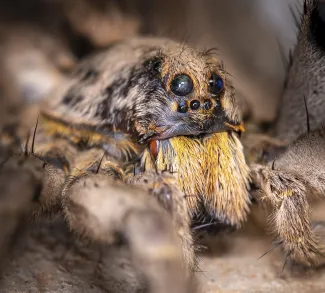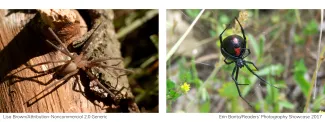
Species in the wolf spider family can often be identified by their eye arrangement: two half-moon-shaped eyes on the side, two larger forward-facing eyes in the middle, and four smaller forward-facing eyes forming a bottom row.
Colton Herzog, a PhD student studying how spiders cycle nutrients through ecosystems at Oklahoma State University, has been fascinated by spiders since childhood. And though his early interest in and passion for the eight-legged creatures has turned into an academic career, he understands that spiders can make people uncomfortable.
“For most people, spiders have an uncanny ‘ick’ about them,” Herzog said. “But spiders are still a vital part of our ecosystems.”
To help boost comfort levels around spiders, Herzog and Cheyenne Gonzales, a wildlife biologist with the Wildlife Department, shared tips for living – or at least existing – with eight-legged visitors in our homes and spaces.
“We want people to walk away knowing more about and having a better appreciation of spiders,” Gonzales said. “You don’t have to like them, but I hope you’ll learn to appreciate them.”
Know Which Spiders are Medically Significant

The brown recluse and black widow are the two medically significant spiders found in Oklahoma.
“Most spiders produce venom but not all spider venom is harmful to humans,” Herzog said.
Only two groups of spiders found in the U.S. – recluses and widows – are considered medically significant to humans. In Oklahoma, that grouping can be narrowed even further to include only the brown recluse and black widow. And it’s the female, not the male, that has the toxic bite.
“At a molecular level, the female widow’s venom is different than the male’s,” Herzog said. “They have neurotoxic venom. A bite from a black widow is similar to really bad food poisoning for a few days.
“Brown recluses have a necrotic venom. If bitten, the skin can decay and die. A bite from a recluse can look a lot like a staph infection if left untreated.”
Take the Spider … and the Spider Bite … to the Doctor
Even though most spiders found in the United States aren’t dangerous to humans and U.S. deaths attributed to spider bites are rare, negative reactions to spider bites do occur and should be examined and treated by a medical professional.
“If you’re bitten by a medically significant spider, please seek medical attention,” said Gonzales. “It’s best to take the spider – even if its squished – with you.”
Keep it Tidy
“The key to removing spiders from your home long-term is eliminating their habitat,” Gonzales said.
Reducing clutter by keeping clothes and shoes off the floor, keeping bulky objects out of the corners, and reducing the stacks of magazines, boxes, or gear that can easily accumulate can reduce the number of spiders in the home.
Avoiding Spider Bites
If your life naturally comes with a side of clutter, Gonzales and Herzog offer a few suggestions for avoiding spider bites.
“Knowing where spiders might be hiding is one of the best ways to avoid bites,” Gonzales said.
Recluses and widows are both nocturnal and prefer dark, quiet areas. "So, be mindful when you’re picking up objects or furniture that have been left on the ground or in the back of a dark closet.
“It’s also a good idea to shake out your clothes and shoes, especially if they’ve been left on the floor. Compression makes spiders panic. If a spider is in the sleeve of the shirt you’re putting on and gets compressed, it’s more likely to bite.”
Herzog said, “If I’m going to be working in an area with a lot of spiders, cleaning out a garage or messing with cardboard boxes, I just wear gloves and don’t really worry about a bite.”
Enjoy the Free Pest Control
If you’re comfortable with spiders, or maybe just looking for a reason to try to get comfortable, Herzog says that tolerating certain spiders in the home may come with the side benefit of free pest control.
“They eat so many insects. They’re really good pest control for humans.
“Spiders also eat other spiders. If they’re in the house, I just let them have their war.”
Catch and Release
While spiders can provide free pest control in the house, they’re even more valuable outside.
“Their excreta and the husks of their prey is ‘plant food 2.0.’” Herzog said. “For other animals, spiders are also a good food source. They hyper-accumulate lipids and other vital nutrients that are necessary to predators of spiders such as fish, birds, reptiles, and other spiders.”
Gonzales explained how to catch and release a wolf spider, a quick-moving spider that has long legs used to chase down prey, in a recent demonstration.
🎥 Watch as Cheyenne Gonzales demonstrates how to catch a wolf spider.
“A lot of times I’ll take the container, or whatever I’m catching it in, and place it in the direction that it’s running,” Gonzales says. “Putting it directly in front of them and guiding them in is typically how I do it.”
Herzog admits he doesn’t enjoy finding brown recluse spiders in his house, but doesn’t mind living with other species that may be found indoors.
“For me, the rest are just neighbors.”
